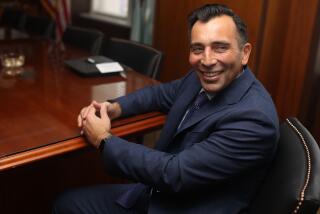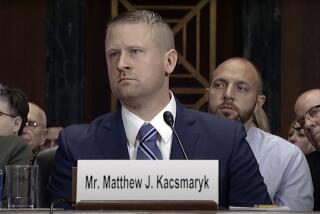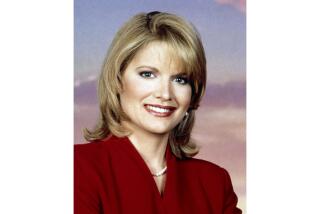Before Bush, U.S. Judge in Texas Was Miersâ Hero
WASHINGTON â When U.S. District Judge Joe Estes of Dallas died on his 86th birthday, they held his funeral at the Highland Park United Methodist Church. His former law clerk Harriet E. Miers gave the eulogy.
âThe verdict is sure and unanimous,â she said. âJudge Estes was a great man.â
Estes was Miersâ first mentor, her hero in the law, the role model who changed her life after her father became seriously ill and before she was drawn headfirst into the world of George W. Bush. For two years, she served as his law clerk at the federal courthouse in downtown Dallas.
But she knew Estes for two decades, continuing to immerse herself in his family as well, growing ever closer to his wife, a mystery-book author; his son, a Houston lawyer who had clerked for a Supreme Court justice, and his daughter, now a university professor in California.
Most mornings, Miers met Estes at his ranch-style home in Dallas. They would climb into his white Ford and, Miers at the wheel, head down the circle drive and off to the courthouse. She spent lunchtime with him at a downtown diner, or sometimes at the more fashionable Dallas Club.
On his birthdays, Miers sent greeting cards. She turned up in family photographs. With the judge in retirement, suffering from Alzheimerâs and other ailments, she dropped in for visits, usually with a gift or two in hand.
Estes prized loyalty from his clerks, and in Miers he got it -- much as Bush did as governor of Texas and now as president.
As Bushâs nominee to the Supreme Court, Miers has been effusive in her praise of the president. She has called him âbrilliantâ and a âgeniusâ and showered him with greeting cards.
âShe was extremely loyal to the judge,â said Tom Murto, a Dallas attorney who clerked for Estes along with Miers. âThat was just part of her character; thatâs where all that began. She came to believe that if youâre going to continue working for somebody, youâre going to be loyal to them.â
Joe Ewing Estes came from East Texas. He built his law career as an oil and gas litigator and was appointed a federal judge in 1955. He was a conservative âEisenhower Democratâ in a state where Republicans were scarce.
Estes took the bench on the second floor of the courthouse off Pearl Street when Miers was 10 years old. Soon afterward he approved a school desegregation timetable, and was barraged with threats and hate mail.
Opponents hung an effigy of Estes at a downtown intersection. The head and hands were painted black, with splotches of red paint to signify blood. âA terrible way to die,â warned the sign on the effigy.
The judge got an unlisted phone number.
When Miers was a student at Southern Methodist University, Estes heard a case involving the mail-order rifle that Lee Harvey Oswald had used to kill President Kennedy. The assassinâs widow was trying to get the weapon from the National Archives to sell it to a Denver oilman for as much as $45,000. The judge ruled that the government should keep the rifle.
When Miers went to work for Estes in 1970, she was the second woman he had selected as a law clerk in an era when female lawyers were as rare as Texas Republicans.
The first, Fairy Rutland -- now a state government lawyer in Austin -- was one of three female law students in a class of 100 at the University of Texas. âThe judge was kind of on the cutting edge of opening the doors for young women lawyers,â Rutland said. âHe gave people like me and Harriet a great opportunity.â
Miers and those who clerked alongside her recalled less about the cases they researched than the education Estes dispensed.
âJudge Estes was like a demanding grandfather,â Murto said. âHe would tell us about his past career and developments and changes in the law.â When he brought a clerk along for a noon meal, Murto said, âyou learned a lot.â
Howard Tygrett, now a state judge in Kaufman, Texas, said Estes had inspired him to become a judge.
Donald Griffis, a lawyer in San Angelo, Texas, said Estes had a special affection for Miers. âShe would have been his favorite of the law clerks,â Griffis said, âbecause of her ability and her common sense and her ethic. Harriet would just work so diligently, and she was always appreciative.â
Estes was dismayed that none of the Dallas firms wanted to hire a woman. So when Miersâ clerkship came to an end in 1972, he contacted the prestigious Locke Purnell firm. Miers was hired.
âI remember my dad talking about how much he learned about discrimination against women,â said Carrol Estes, a health policy professor at UC San Francisco. âHe really got it when Harriet couldnât find a job.â
In her eulogy for the judge -- a tape of which was provided by Estesâ son, Carl -- Miers recalled that he had to do a good bit of badgering to get her hired, finally convincing the men at the firm that âshe works hard, she works late and she takes things home.â Miers added, âWhatever he said worked.â
She went on to head the Dallas Bar Assn., as Estes had. She became president of the state bar, a position he had been about to assume when he was picked by President Eisenhower for the federal court. Both were workaholics. And they enjoyed each otherâs company.
Well after her clerkship, Miers could still be found at the Estes family dinner table on Thanksgiving, Christmas and Easter. She lived a mile away, which made visiting easy, especially as the judge grew older.
Carl Estes said that âshe became more a part of our family than most people would. She was a single woman, and the one thing I remember most about her was her loyalty. I guess itâs like the old saying, âIf you have a daughter, you have a daughter for life.â â
By the late 1980s, the judge was afflicted with Alzheimerâs, and Miersâ face was one of the last ones he recognized. He died in 1989, the year she won a two-year term on the Dallas City Council. By then she also was running the law firm.
Five years later, Miers found a new mentor when she went to work as general counsel in Bushâs successful campaign for governor in Texas.
This month, when Miers submitted answers on a Senate Judiciary Committee questionnaire examining her qualifications for the Supreme Court, she listed Estes as among her greatest influences.
She said he âhelped to instill in meâ the importance of judicial independence.
âHe decided every case according to the law and facts, and he did not worry about the potential for a negative reaction to his decisions,â she told the committee.
âHe felt no pressure to please anyone. His only lodestar was the law.â
*
Times researcher Vicki Gallay in Los Angeles contributed to this report.
More to Read
Sign up for Essential California
The most important California stories and recommendations in your inbox every morning.
You may occasionally receive promotional content from the Los Angeles Times.











